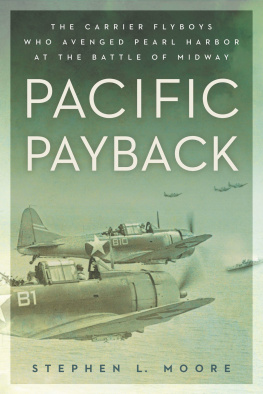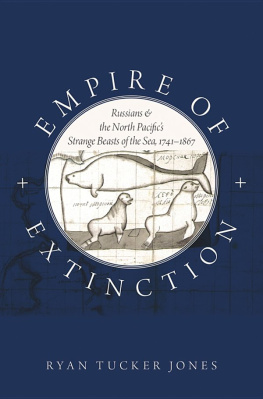Enlightenment and Exploration in the North Pacific, 17411805
Port Dick near Cook Inlet as sketched by H. Humphreys on Vancouvers 1794 northern survey (Hydrographic Office, Taunton, Somerset).
The original sketch included no ethnographic detail. In the published version reproduced on the cover of this book, engraver B. T. Pouncy added canoes and Native hunters. The explorers had seen such a flotilla in the area.
Copyright 1997 by the Cook Inlet Historical Society
Printed in the United States of America
Design by Audrey Meyer
All rights reserved. No part of this publication may be reproduced or transmitted in any form or by any means, electronic or mechanical, including photocopy, recording, or any information storage or retrieval system, without permission in writing from the publisher.
Library of Congress Cataloging-in-Publication Data
Enlightenment and exploration in the North Pacific, 17411805
edited by Stephen Haycox, James Barnett, Caedmon Liburd.
p.cm.
Includes index.
ISBN 0-295-97583-0 (alk. paper)
1. AlaskaDiscovery and explorationEuropean.2. AlaskaHistoryTo 1867.3. ExplorersAlaskaHistory18th century.4. ExplorersNorthwest, PacificHistory18th century.5. Northwest, PacificDiscovery and explorationEuropean.I. Haycox, Stephen W.II. Barnett, James, 1947III. Liburd, Caedmon.IV. Cook Inlet Historical Society.V. Anchorage Museum of History and Art.
F907.E55 1997
979.801dc21
96-37993
CIP
The paper used in this publication meets the minimum requirements of American National Standard for Information SciencesPermanence of Paper for Printed Library Materials, ANSI Z39.48-1984.
Cover photo: Port Dick near Cook Inlet, engraving by B. T. Pouncy, based on a sketch made by H. Humphreys on Vancouvers 1794 northern survey (The Anchorage Museum of History and Art)
Preface
I n October 1994, the Cook Inlet Historical Society of Anchorage, Alaska, hosted sixteen international scholars at an invitational symposium commemorating the bicentennial of the survey voyage of George Vancouver on the Northwest Coast as far north as Cook Inlet in 179294. Expanding the work of James Cook in 177879, Vancouver began work in the south each of the first two years but started the third seasons endeavors at Eagle River, several miles above Point Woronzof in Knik Arm, one of two branches that form the head of Cook Inlet and that today embrace the city of Anchorage, a modern metropolis of more than a quarter million people. In recognition of the bicentennial of Cooks first charting of Cook Inlet waters, the City of Anchorage in 1978 commissioned a James Cook statue. Today the likeness stands on the bluff overlooking those waters just at the apex of downtown Anchorage, a source of pride and respect for the citys residents and of interest and information for its visitors. This publication of scholarly papers constitutes Anchorages tangible recognition of the significance of Vancouvers voyage, as well as the legacy of the Cook Inlet Historical Societys 1994 Vancouver Symposium.
The Cook Inlet Historical Society is dedicated to the collection and interpretation of regional history. It is headquartered in the Anchorage Museum of History and Art and is a support group for that museum, which is a principal cultural institution for the city, region, and state. All of the activities associated with the Symposium, Exploration in the North Pacific, 17411805, were held at the Anchorage Museum of History and Art.
The audience for the symposium was the general public, which has responded enthusiastically to the efforts of the society through many years, and did so again for this event. Attendees included visitors from a number of states and countries, as well as many local residents, including interested faculty and students from the Anchorage campus of the University of Alaska and from private Alaska Pacific University.
In preparation for the symposium, the society hosted a series of monthly lectures on the history of European exploration of the Northwest Coast. Professor Richard Pierce of the University of Alaska Fairbanks (UAF) reviewed Russian discovery and exploitation of the northern reaches of the coast; Professor Marvin Falk of the Rasmuson Library at UAF surveyed the cartographic context of North Pacific exploration; Professor Donald Cutter of the University of New Mexico recounted the Spanish voyages along the coast; Dee Longenbaugh of The Observatory bookstore in Juneau noted the beginnings of the maritime fur trade with the arrival of James Hanna on the coast in the Sea Otter in 1785 and of James Strange with the Captain Cook and Experiment the following year. Kathryn Arndt of Fairbanks presented a paper on Russian exploration of and contact with the Natives of the Yukon-Kuskokwim Delta region; Dr. Nancy Yaw Davis of Anchorage discussed general European and Native responses to contact, while Professor Steve Langdon of the University of Alaska Anchorage discussed Spanish-Tlingit relations in Bucareli Bay in the context of Native social maturity. Finally, James Barnett of Anchorage summarized the significance of Vancouvers role in the broader context of Enlightenment maritime exploration, noting the convergence on the Northwest Coast of diverse European energies and a variety of sophisticated Native cultures. This series provided a useful context for the original contributions of the scholars who convened in Anchorage in October. Two of the preparatory lectures, by Langdon and Barnett, are included in the present anthology.
Drawing upon current analysis of Vancouvers achievements, symposium planners solicited papers for the October meeting in several specific research areas. The salient factors that motivated the several European nations to dispatch expeditions to the coast seemed a significant arena of discussion. These included the peculiar conditions and leaders in each country, which bore on planning and financing. Some recent scholarship has addressed the role of capitalist and imperial expansion and competition in the European advance upon the Americas, which at the same time drew the aboriginal inhabitants of the Americas into the developing world market system. And while national economic interest as well as personal glory and religious fervor were major incentives, few explorers manifested or elaborated clear and conscious insight into the role of capitalist expansion in the European Enlightenment, and those who did took for granted its validity. Several papers in this collection address economic motivation and its implications in the changing world of the eighteenth century.
Encounters with American aborigines constituted one of the more significant of the explorers activities. Several papers dealt with Native contact from diverse points of view, including comparative analysis of Spanish understanding of aborigines in Tonga, the manipulation of images of Natives by European artists and their publishers, the approach to collecting Native artifacts, and an assessment of the interpretive paradigms historians have brought to the study of contact.






